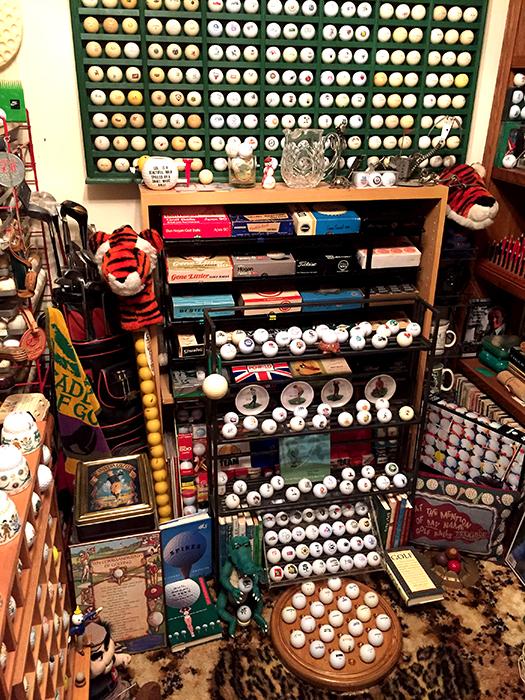Golf balls are a fascinating subject and one of the most popular collectibles given their rich and varied past. Below you will find links to stories/features on the ball, an introduction to golf ball collecting, and a personal account from collector Rae Ecklund.
A short history of golf ball dimples and patterns.
Ball Collecting Categories
High-end collectibles
Featheries pre-1848

Feather ball made by Wm. Robertson.
Before the invention of the gutta percha ball in 1848, balls were made of leather pouches stuffed with feathers that were soaked in brine. When the feathers dried, the ball was very hard and sturdy, at least for a time. They were difficult to make and expensive. Balls were generally stamped with the maker’s name and weight of the ball. Highly collectible names include Gourlay, McEwan, and Allan. Such balls, in good condition, regularly fetch enormous sums at auction. Collecting such balls requires knowledge and expertise to determine worth and authenticity.
Gutta percha 1848-1902
Discovered by chance as a useful substance for golf balls, gutta percha balls in their early years are highly desired by collectors. The early balls were smooth and flew erratically. Golfers then discovered that the scratches, dents and injuries delivered to these balls actually straightened their flight. Thus began decades of exploration in surface manipulation with grooves, dimples, pimples (called brambles), mesh, and any number of other patterns. Collectors of gutta percha balls rate them according to patterns, age, and, of course, condition. As with featheries, auction prices can be in the many thousands of dollars with prized samples going for quite breathtaking sums. Here, too, is the realm of the expert collector. The casual collector would do well to find second or third rate balls in less desirable condition to at least display for their historical value in the evolution of the ball.

Early rubber core – 1900-1920
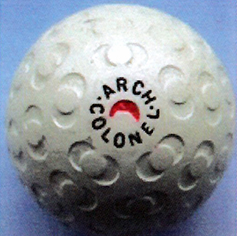
Around the turn of the 20th century, the golf ball took another leap forward with the invention of the wound, rubber core ball. Supplanting the gutty over a period of just a few years, the rubber core, or “bounding billy” as the early ball was known, took off, literally, with golfers who discovered its penchant for to add distance to their games. The early balls varied in size and weight. Core materials varied widely as inventors tried almost everything from a hollow core, to compressed air, honey, steel, a radioactive substance, and, in one bizarre instance, the pizzle (penis) of a bull! Yes, you read that right. Such were the many patterns, weights, cores, that collecting balls from this period involves much research to understand the many patents and varieties. It is a particularly rich period for collectors and balls can be found ranging from reasonable prices to very high for prized and rare patent balls.
Rubber core 1920-1940
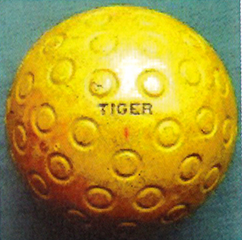
The ball was still undergoing experimentation as manufacturers jockeyed for position in the market. Surface patterns in the early 20s were just as inventive and unusual as the earlier decade. As time wore on, the golf ball market began to settle down as more consistent manufacturing processes took hold and key makers began to dominate. The collector for this period will look for early maker names and try to assemble a progression that shows the evolution of both the ball and its marketing and maker iterations.
Characteristics of rubber core collecting involve looking for moulded or hand-cut gutties; wrapped and uwrapped balls, golf ball boxes (fascinating in their colorful varieties), even fakes, which have, when known, a certain collectible appeal. Wooden balls, too, were available for short time during war years.
1940s-Current
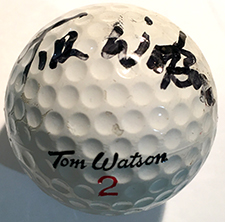
Collectors of balls for this period have many choices should they wish to focus on a particular niche, as these include balls with logos of from anything to universities to sports clubs and everything in between; corporate brands (logos); images of any number of things from animals to birds; joke balls, balls with the names of professional golfers, sometimes in script; autographed balls, itself a category as collectors often like to build a display of balls that the golfer him or herself has signed.
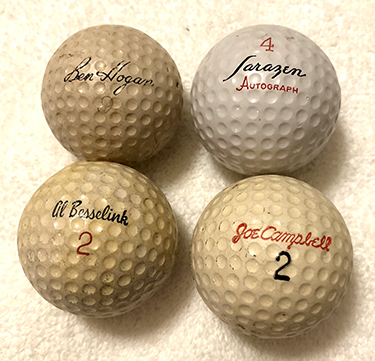
Other niches include golf ball boxes, practice balls, and early golf ball advertising displays and posters.
An example of how hot the market can be for golf balls is evidenced by the $64,000 paid at auction for a Tiger Woods golf ball used during his first Masters victory in 1997. Click here for that story.
Some recommended golf ball collecting or historical guides:
- 500 Years of Golf Balls, by John F. Hotchkiss, 1997, Antique Trader Books
- The Essential Guide to Collecting Golf Balls, by Colin Palmer, 2010, Riley Dunn & Wilson Ltd.
- Antique Golf Collectibles, 3rd Edition, by Chuck Furjanic, 2004, Krause Publications
- Golf in the Making, by Ian Henderson and David Stirk, 1979, Henderson & Stirk Ltd.
- The Encyclopedia of Golf Collectibles, by John Ohlman and Morton Ohlman, 1985, Books Americanna
- Antique Golf Collectibles, Identification and Value Guide, by Pete Georgiady, 2006, Collector Books
- The Story of the Golf Ball, by Kevin W McGimpsey, 2003, Philip Wilson, London (winner of the 2004 Murdock Medal presented by the British Golf Collectors Society)
- The Collectible Golf Ball Directory, Folio I, ‘Gutta-Percha’ golf balls 1845-1903, by Kevin W McGimpsey, 2021
- The Collectible Golf Ball Directory, Folio II, ‘Rubber-Cored’ golf balls 1901-1919, by Kevin W McGimpsey, 2022
- The Collectible Golf Ball Directory, Folio III, ‘Rubber-Cored’ golf balls, A-K 1920-1945, by Kevin W McGimpsey, 2023 [November]
Having a Ball Collecting Golf Balls
By Rae A. Ecklund
I am not a golfer, unless you count the times I played a few rounds on a Putt-Putt course, but my husband, Gary Proctor, is and once I got him hooked on going to garage sales, flea markets, estate sales, antique shops, thrift shops and rummage sales with me, he also evolved into a collector of vintage wood-shafted golf clubs, with which he now plays golf and repairs as well.
I once collected marbles and had an extensive collection that I sold for a handsome price. Gary’s passion for golf led me to think that golf balls might fill the collecting void left by “the loss of my marbles.” Thus a new hobby (for me) was born. Now, many years later I admit I enjoy the golf balls more than I did the marbles, mostly because other people relate to golf balls better than marbles. Just about everybody is familiar with golf even if they don’t play the game.
Nor do they have to play golf to find my golf ball collection interesting, the majority of which does not involve antique and rare golf balls such as featheries, brambles, and gutta perchas, which are way before my time and considerably expensive to acquire. (See above for information on collecting those balls.) Instead, my collection mainly involves balls from my own era – the 1940s to the present.
Older ones are challenging to find in pristine condition, especially those that are imprinted with pro-golfers names, sometimes in a script to resemble an autograph. In turn, what adds interest and collectibility to many current golf balls is the printing on their surfaces – of company logos, brands, and/or products. These are often referred to as “advertising,” “brand,” or “logo” balls. Some have the names and logos of golf courses, places and things. Others display cartoon characters, humorous sayings, animals, birds – you name it, someone has created a golf ball decorated with something important to them. For me, these are fun to find and display.
In fact, the Ball Room in our house is not for dancing. Visitors are generally fascinated by the displays of several thousand golf balls with different themes, logos, etc. Most recognize one or more groupings of special interest to them and are inspired to share stories of their own regarding what golf ball(s) caught their interest in particular or about golf ball displays in general. That to me is where the real value lies in collecting – the conversations such a collection generates and the friendships begun or enhanced as a result.
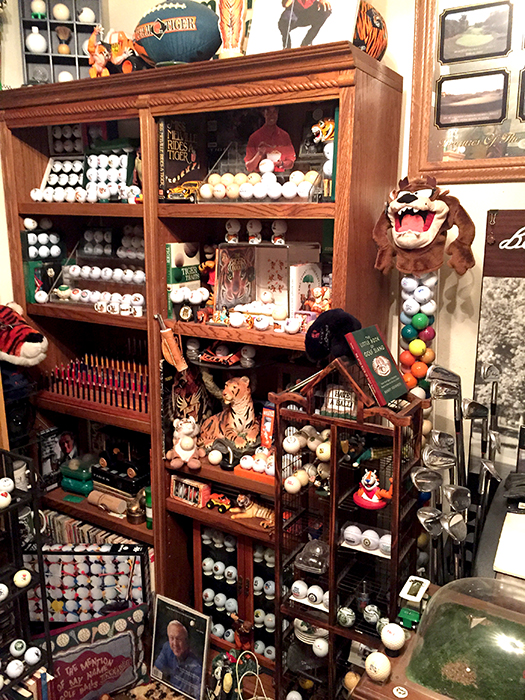
One such friend is Rives McBee, a retired professional golfer whose enviable collection includes golf balls hand-signed by fellow pro golfers he has met on tour and the priceless stories that come with them. I’ve proudly created a golf ball display in the Ball Room dedicated to Rives, honoring both his notable career and our decades-long friendship that evolved from a shared interest in golf ball collecting.
Bear in mind that collectible golf balls are worth only what someone is willing to pay for them. Garage or rummage sales may turn up a whole bucket for $5 or less. I have paid as much as a dollar a ball and as little as a nickel. Sometimes people give me balls free if they just want to get rid of clutter. I once went to a garage sale and bought a large, beautiful wooden golf ball display unit for just $10 that included a bag of several dozen golf balls which I didn’t even look through until I got them home. I discovered each ball featured a different golf course from around the world! I learned that their owner had been a commercial airline pilot, who played golf wherever his flights took him and that he’d saved a ball from each of those courses. The family, to my amazement, was not interested in the balls, so I am now curator to this man’s golf and travel history. The lesson, of course, is that value is in the eye of the beholder.
My primary advice to beginning ball collectors is that you focus on the ones which interest you, enjoy them and the process of finding and displaying them, and let that be their primary worth. Egg cartons work great to store balls that you don’t have room to display. Sometimes a spin-off collection comes out of items used to display golf balls. For example, I now have a secondary collection of unusual shot glasses each of which serves as an individual, decorative golf ball holder.
As with all collections, whatever you invest in time, money and creativity hopefully brings rewarding satisfaction above all else and opens doors to possibilities you never imagined existed. Who knows? I might still become a golfer, one supplied with a couple hundred thousand golf balls to hit into the rough. FORE!
